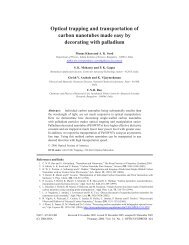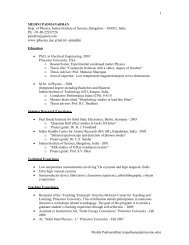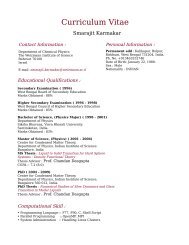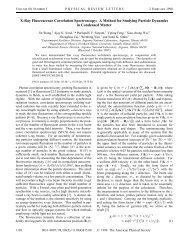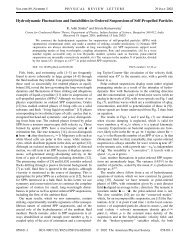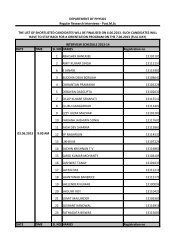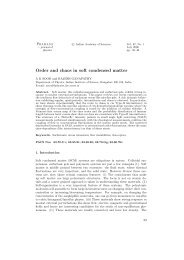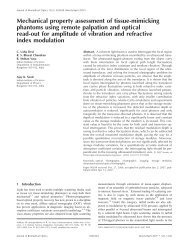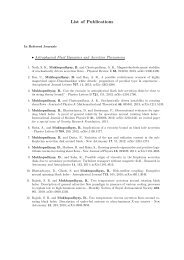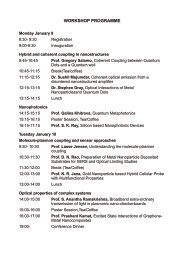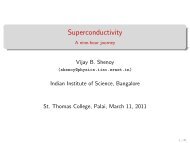Thermoelectric Properties of Fe0.2Co3.8Sb12-xTex ... - Physics
Thermoelectric Properties of Fe0.2Co3.8Sb12-xTex ... - Physics
Thermoelectric Properties of Fe0.2Co3.8Sb12-xTex ... - Physics
You also want an ePaper? Increase the reach of your titles
YUMPU automatically turns print PDFs into web optimized ePapers that Google loves.
Freezing <strong>of</strong> the octahedral tilt near ferromagnetic transition and appearance <strong>of</strong> a glassy<br />
phase at low temperature driven by the tilt instabilities in SrRuO 3<br />
Chanchal Sow<br />
Department <strong>of</strong> <strong>Physics</strong>, Indian Institute <strong>of</strong> Science, Bangalore 560012, India<br />
SrRuO 3 is a well known itinerant ferromagnet with many intriguing characteristics. Here we<br />
present a critical investigation on the structural, magnetic, and magnetotransport properties <strong>of</strong><br />
polycrystalline SrRu (1-x) O 3 (0.07 < x < 0) samples with uniquely defined ferromagnetic transition<br />
temperatures. The ac magnetic susceptibility study exhibits the remarkable memory effect, a<br />
distinct characteristic <strong>of</strong> glassy behavior, at low temperatures. The transport study suggests a<br />
crossover from Fermi-liquid to non-Fermi-liquid behavior. Most strikingly, the temperaturedependent<br />
magnetoresistance reveals the possibility for an additional magnetic ordering (apart<br />
from ferromagnetic) by demonstrating a peak in magnetoresistance at the low temperature side<br />
as well. In addition, the temperature-dependent coercive field shows a plateau around 50 K. In<br />
order to understand the genesis <strong>of</strong> such unusual low-temperature magnetic features, we have<br />
undertaken a detailed temperature dependent (5-250 K) neutron diffraction study. We observe a<br />
freezing <strong>of</strong> the octahedral tilt near the ferromagnetic transition and unusual changes in the<br />
structural parameters (unit-cell lattice parameters, octahedral tilt etc.) near the onset <strong>of</strong> low<br />
temperature spin glass like phase. A reduction <strong>of</strong> the ordered magnetic moment and a decline in<br />
the total integrated magnetic intensity is also observed around the same temperature. Hence it is<br />
believed that the low-temperature anomalous magnetic response is closely intertwined to the<br />
lattice-parameter change.<br />
Reference:<br />
[1] C. Sow, D. Samal, P. S. A. Kumar, A. K. Bera, and S. M. Yusuf, Phys. Rev. B 85, 224426<br />
(2012).<br />
[2] C. Sow, D. Samal, and P. S. A. Kumar, J. Appl. Phys. 111, 07E121 (2012).



